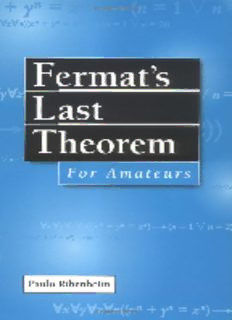
Fermat's Last Theorem for Amateurs PDF
Preview Fermat's Last Theorem for Amateurs
Preface ItisnowwellknownthatFermat’slasttheoremhasbeenproved. For more than three and a half centuries, mathematicians — from the greatnamestothecleveramateurs—triedtoproveFermat’sfamous statement. The approach was new and involved very sophisticated theories. Finallythelong-soughtproofwasachieved. Thearithmetic theory of elliptic curves, modular forms, Galois representations, and their deformations, developed by many mathematicians, were the tools required to complete the difficult proof. Linked with this great mathematical feat are the names of TANI- YAMA, SHIMURA, FREY, SERRE, RIBET, WILES, TAYLOR. Their contributions, as well as hints of the proof, are discussed in the Epilogue. This book has not been written with the purpose of presentingtheproofofFermat’stheorem. Onthecontrary,itiswrit- ten for amateurs, teachers, and mathematicians curious about the unfolding of the subject. I employ exclusively elementary methods (except in the Epilogue). They have only led to partial solutions but their interest goes beyond Fermat’s problem. One cannot stop admiring the results obtained with these limited techniques. Nevertheless, I warn that as far as I can see — which in fact is not much — the methods presented here will not lead to a proof of Fermat’s last theorem for all exponents. vi Preface The presentation is self-contained and details are not spared, so the reading should be smooth. Most of the considerations involve ordinary rational numbers and only occasionally some algebraic (non-rational) numbers. For this reason I excluded Kummer’s important contributions, which are treated in detail in my book, Classical Theory of Algebraic Num- bers and described in my 13 Lectures on Fermat’s Last Theorem (new printing, containing an Epilogue about recent results). There are already — and there will be more — books, mono- graphs, and papers explaining the ideas and steps in the proof of Fermat’s theorem. The readers with an extended solid background will profit more from reading such writings. Others may prefer to stay with me. In summary, if you are an amateur or a young beginner, you may love what you will read here, as I made a serious effort to provide thorough and clear explanations. On the other hand, if you are a professional mathematician, you may then wonder why I have undertaken this task now that the problem has been solved. The tower of Babel did not reach the sky, but it was one of the marvels of ancient times. Here too, there are some admirable examples of ingenuity, even more remarkable considering that the arguments are strictly elementary. It would be an unforgivable error to let these gems sink into oblivion. As Jacobi said, all for “l’honneur de l’esprit humain.” August, 1997 Paulo Ribenboim Reader You may feel tempted to write your own (simpler) proof of Fermat’s last theorem. I have strong views about such a project. It should be written in the Constitution of States and Nations, in the Chapter of Human Rights: It is an inalienable right of each individual to produce his or her own proof of Fermat’s last theorem. However, such a solemn statement about Fermat’s last theorem (henceforth referred to as THE theorem) should be tempered by the following articles: Art. 1. No attempted proof of THE theorem should ever duplicate a previous one. Art. 2. It is a criminal offense to submit false proofs of THE theorem to professors who arduously earn theirlivingbyteachinghownottoconceivefalseproofs of THE theorem. Infringement of the latter, leads directly to Hell. Return to Par- adise only after the said criminal has understood and is able to re- produce Wiles’ proof. (Harsh punishment.) This page intentionally left blank Contents Preface v Reader vii Acknowledgment xiii The Problem 1 I. Special Cases 3 I.1. The Pythagorean Equation 3 I.2. The Biquadratic Equation 11 I.3. Gaussian Numbers 21 I.4. The Cubic Equation 24 I.5. The Eisenstein Field 41 I.6. The Quintic Equation 49 I.7. Fermat’s Equation of Degree Seven 57 I.8. Other Special Cases 63 I.9. Appendix 71
Description: